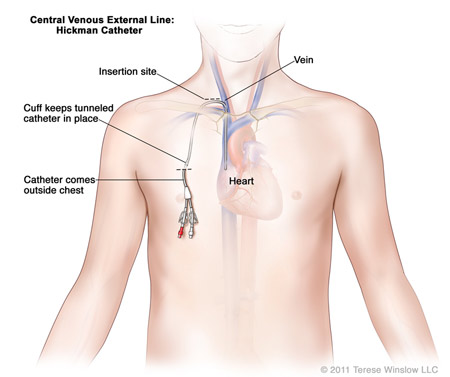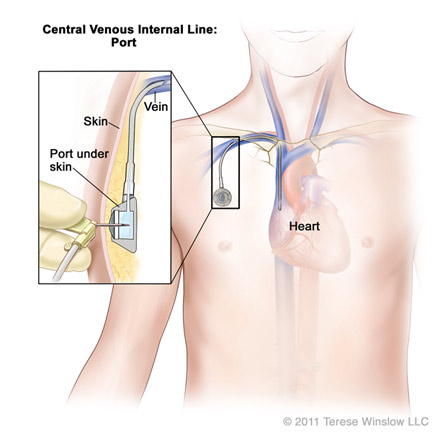Central Lines
Maintaining intravenous (IV) access for children requiring chemotherapy is a challenge. There are devices available to make this process easier. The type of device chosen is dependent upon the type and duration of therapy and personal preference.
The two most common types are:
External catheters (also known as: BROVIAC®, HICKMAN®) – External catheters are tunneled under the skin and are surgically placed in a major vessel of the body, most often in the chest. They are called external because a portion of the catheter is exposed which allows usage without a needle stick. A dressing is required to cover the place where the catheter comes through the skin at all times. The dressing must be changed at regular intervals as directed by your healthcare team.

Using this type of catheter requires that the family learn to administer heparin to keep it functioning and free from infection. The frequency of heparin administration will be determined by your child’s care team. Family members are also taught to change the dressings at home between treatments. "HICKMAN and/or BROVIAC are registered trademarks of C.R. Bard, Inc. and its related company, BCR, Inc."
Subcutaneous ports (also known as: mediport, port-a-cath, port, infusaport) – These devices are surgically placed and are totally implanted into the subcutaneous tissue (tissue that is directly under the skin), most often on the chest. They have an attached catheter that is inserted into a major vessel. A special "huber" (90 degree) needle is inserted through the skin and into the port by a medical professional before the port is used. When it is "accessed," a dressing is required, similar to an external catheter. When not being used, it is out of sight and needs no special care.

Each type of catheter is used the same way - for chemotherapy and other intravenous infusions that are necessary in treating children’s cancer.
Risks of Catheter Use
The most common complications include infection and occlusion (blockage in the line).
Signs of infection in the catheter can include: fever, redness, tenderness, pain, or discharge from the site. Any of these symptoms should be reported to your healthcare team immediately. The healthcare team will evaluate and provide appropriate treatment of the infection.
Occlusion refers to blockage of the catheter by a blood clot (also called a thrombus). The occlusion can be partial or complete. It will be necessary for the healthcare team to evaluate and treat an occlusion.








